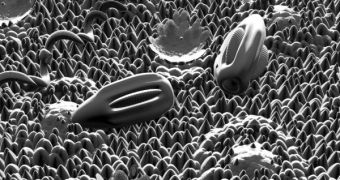It seems that there is virtually no limit to what researchers can do when they put their mind to it, a new success in the area of nanotechnology from the University of Oxford shows. The scientists there succeeded in creating a two-legged walking nanobot that can navigate a single strand of DNA, without losing its grip as it goes. This is a major breakthrough in building molecular machines, as other similar projects failed to design an error-proof system, to prevent the machine from leaving the strand and become useless. The way the Oxford researchers accomplished that is simply ingenious.
Getting a nanobot – basically, an artificial machine made up of DNA bits and other molecules – to walk on a DNA strand without losing its grip, while at the same time receiving power to function and never stopping is every bit as difficult to accomplish as it sounds.
First, the problem of walking gave scientists the hardest time. In order to prevent both feet from lifting at the same time, and to avoid the machine from coming loose off the DNA strand, the team adopted a clever solution – they forced the legs to compete for grip, which means that as one leg “steps” down, the other is forced to lift, thus always securing a solid foothold.
At the same time, while ensuring grip, the rising foot generates energy for the whole device, by forcing molecules around it to release it, due to friction. This also solves the problem of a continuous fuel supply. And because one leg has to be lifted all the time, the possibility of going backwards is eliminated. This means that the machine will walk front-only, and will not waste time going back and forth with no aim.
"At the moment, the nanobot has taken a single step but our ambition is to make it move 100 nanometres or more," says the leader of the research at the University of Oxford, Andrew Turberfield.
"We can already stop and start our motor by controlling the amount of fuel we add, but we could add other control signals to make walkers interact with each other, and could easily attach a cargo to the region that links the two legs," he adds, saying that the applications that a solid design could undergo are virtually limitless.

 14 DAY TRIAL //
14 DAY TRIAL //